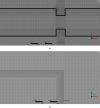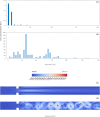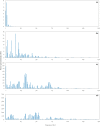A CFD-FFT approach to hemoacoustics that enables degree of stenosis prediction from stethoscopic signals
- PMID: 37449099
- PMCID: PMC10336451
- DOI: 10.1016/j.heliyon.2023.e17643
A CFD-FFT approach to hemoacoustics that enables degree of stenosis prediction from stethoscopic signals
Abstract
In this paper, we identify a new (acoustic) frequency-stenosis relation whose frequencies lie within the recommended auscultation threshold of stethoscopy (< 120 Hz). We show that this relation can be used to extend the application of phonoangiography (quantifying the degree of stenosis from bruits) to widely accessible stethoscopes. The relation is successfully identified from an analysis restricted to the acoustic signature of the von Karman vortex street, which we automatically single out by means of a metric we propose that is based on an area-weighted average of the Q-criterion for the post-stenotic region. Specifically, we perform CFD simulations on internal flow geometries that represent stenotic blood vessels of different severities. We then extract their emitted acoustic signals using the Ffowcs Williams-Hawkings equation, which we subtract from a clean signal (stenosis free) at the same heart rate. Next, we transform this differential signal to the frequency domain and carefully classify its acoustic signatures per six (stenosis-)invariant flow phases of a cardiac cycle that are newly identified in this paper. We then automatically restrict our acoustic analysis to the sounds emitted by the von Karman vortex street (phase 4) by means of our Q-criterion-based metric. Our analysis of its acoustic signature reveals a strong linear relationship between the degree of stenosis and its dominant frequency, which differs considerably from the break frequency and the heart rate (known dominant frequencies in the literature). Applying our new relation to available stethoscopic data, we find that its predictions are consistent with clinical assessment. Our finding of this linear correlation is also unlike prevalent scaling laws in the literature, which feature a small exponent (i.e., low stenosis percentage sensitivity over much of the clinical range). They hence can only distinguish mild, moderate, and severe cases. Conversely, our linear law can identify variations in the degree of stenosis sensitively and accurately for the full clinical range, thus significantly improving the utility of the relevant scaling laws... Future research will investigate incorporating the vibroacoustic role of adjacent organs to expand the clinical applicability of our findings. Extending our approach to more complex 3D stenotic morphologies and including the vibroacoustic role of surrounding organs will be explored in future research to advance the clinical reach of our findings.
Keywords: Acoustics; CFD; Hemodynamics; LES; Phonocardiography; Stenosis; Strouhal.
© 2023 The Author(s).
Conflict of interest statement
The authors declare that they have no known competing financial interests or personal relationships that could have appeared to influence the work reported in this paper.
Figures





















Similar articles
-
A 3D scaling law for supravalvular aortic stenosis suited for stethoscopic auscultations.Heliyon. 2024 Feb 15;10(4):e26190. doi: 10.1016/j.heliyon.2024.e26190. eCollection 2024 Feb 29. Heliyon. 2024. PMID: 38390109 Free PMC article.
-
Bio-acoustic signals from stenotic tube flow: state of the art and perspectives for future methodological development.Med Biol Eng Comput. 1995 Sep;33(5):669-75. doi: 10.1007/BF02510784. Med Biol Eng Comput. 1995. PMID: 8523908 Review.
-
Frequency Responses of Conventional and Amplified Stethoscopes for Measuring Heart Sounds.Saudi J Med Med Sci. 2020 May-Aug;8(2):112-117. doi: 10.4103/sjmms.sjmms_118_19. Epub 2020 Apr 17. Saudi J Med Med Sci. 2020. PMID: 32587492 Free PMC article.
-
Deep learning-based hemodynamic prediction of carotid artery stenosis before and after surgical treatments.Front Physiol. 2023 Jan 10;13:1094743. doi: 10.3389/fphys.2022.1094743. eCollection 2022. Front Physiol. 2023. PMID: 36703930 Free PMC article.
-
Italian Society of Cardiovascular Echography (SIEC) Consensus Conference on the state of the art of contrast echocardiography.Ital Heart J. 2004 Apr;5(4):309-34. Ital Heart J. 2004. PMID: 15185894 Review.
Cited by
-
A 3D scaling law for supravalvular aortic stenosis suited for stethoscopic auscultations.Heliyon. 2024 Feb 15;10(4):e26190. doi: 10.1016/j.heliyon.2024.e26190. eCollection 2024 Feb 29. Heliyon. 2024. PMID: 38390109 Free PMC article.
References
-
- von Reutern G.-M., Goertler M.-W., Bornstein N.M., Sette M.D., Evans D.H., Goertler M.-W., Hetzel A., Kaps M., Perren F., Razumovky A. Grading carotid stenosis using ultrasonic methods. Stroke. 2012;43(3):916–921. - PubMed
LinkOut - more resources
Full Text Sources
Miscellaneous

